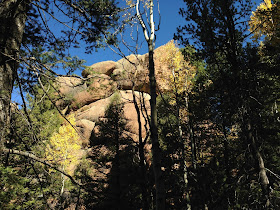 |
| Trail Ridge Road Closed Under Snow - 5 Days Ago |
Snow has already fallen across the peaks of Colorado. Trail Ridge Road in Rocky Mountain National Park is closed under 3 foot deep drifts. Cold white blankets the front range mountains above treeline. Aspen leaves have already fallen. Winter is not far away.
 |
| Similar to my older snowshoes |
Mount Evans and Mueller State Park in the winter were incredibly bright day trips. Then there was that winter trip to Breckenridge with family and friends, where the trail just kept going up and up, and once past the ski runs, I was immersed in perfect solitude until I walked out of my broken snowshoe. The 2 grommets holding the cleat to the straps had worn/broken free. I picked up the pieces and walked back to the lodge, using the good snowshoe to break the snow down to step into with my boot-only foot.
I fixed that snowshoe by replacing the grommets with bolts and washers. I keep some spares with me in case it happens again and always carry 2 small wrenches to tighten them up.
As a family, we owned a few snowshoes. My children each had models made for their light weight and my wife had a set of 20" snowshoes. We all had 2 piece snowshoe poles. I owned a pair of 30" snowshoes for backpacking and my favorite 27" snowshoes, which I still have.
 |
| Snowshoe poles |
I also have one snowshoe bag/backpack and 2 sets of poles left, one pole set I put small baskets on and use for hiking and backpacking. In my pack I have a section of old aluminum tent poles, held together with a bungee cord inside that can double as a rescue probe. Typically I check contour maps prior to a trip to avoid hiking too close to avalanche zones, so I hope to never need to search for anyone. Until trained in avalanche awareness and carrying avalanche beacons, I suggest staying far away from 20 degree avalanche chutes! I also carry a collapsible snow shovel to dig a snow cave or rescue my vehicle. I always carry extra socks and warmer gloves. a winter overcoat, a stove with tea, food and emergency supplies to survive the cold night out if needed.
Snowshoeing makes you heat up fast, so I usually wear a light weight wicking base layer, water-proof/breathable rain pants, gaiters, snow boots, 2 pairs wicking socks, a polar plus 300 jacket (with pit zips) a knit hat and liner gloves. Don't forget your sunglasses to avoid snow blindness. I would keep moving to keep warm, and would put on my water-proof/breathable jacket and winter gloves when the wind picked up. Hiking through the snow can wear you down quickly, so eat every 2 hours or so on the trail and drink plenty of water. Hot chocolate in a thermos is a great pick-me-up after a cold hike too.
Snowshoeing is fairly easy to do.Strap them on over your snow boots snugly and use your poles for balance. Just walk with wide steps so you don't step on your own shoes. Avoid getting too close to the base of pine and fir trees to keep from falling into the void, like I mentioned above. If it gets too steep to cross a hill either sideways or vertically, kick your steps in with the snowshoes. Allow the cleats to dig in for traction, especially into ice when crossing streams. Sometimes, climbing steep patches with lots of rocks near the surface can be tricky; use your poles, take small steps, and keep moving forward. Keep your weight centered above the center cleat of the snowshoes. If there are parallel tracks from cross country skis in the snow, stay off them as someone else may need them! Classes are available at stores like REI, many ski resorts and Nordic centers. Snowshoes are rent-able too, if you want to try them out first.
I have thoroughly enjoyed snowshoeing and look forward to getting out a few times this winter. I'll try to get to hike in interesting places and will share those with you as they happen. Don't let winter keep you inside, get out there and hike!



































